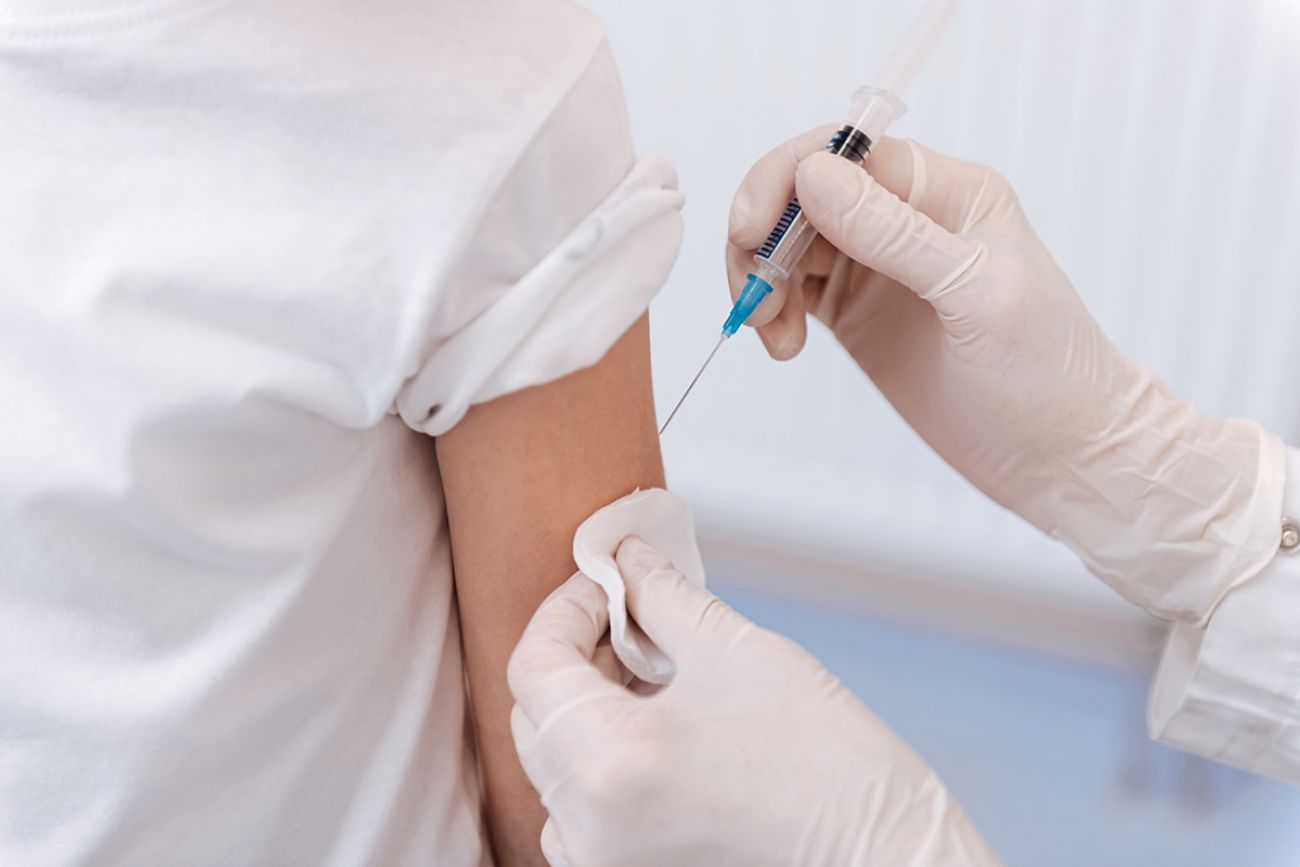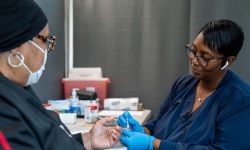CDC loosens COVID rules with new onus on people, not schools, businesses

- The CDC eases COVID-19 recommendations Thursday
- If you’re exposed, forget quarantining. Masks will do.
- Gone, too, are recommendations for routine testing at schools
The Biden administration further relaxed guidelines Thursday for controlling the spread of COVID, moving away from quarantines, social distancing and other security staples of the pandemic.
And in a turn that could have implications for Michigan schools as they begin a new year, the U.S. Centers for Disease Control and Prevention said it is no longer recommending that schools perform routine testing or require students exposed to COVID-19 to test to stay in school. The CDC’s move away from such vetting would also apply to most businesses and other institutions.
The “streamlining” of CDC’s guidance is a nod to the waning lethality of the virus. It’s likely an acknowledgement, too, of the public’s inclination, nearly 2 ½ years into the pandemic, to pick and choose what guidelines they’ll follow anyway.
Related:
- Michigan Gov. Gretchen Whitmer tests positive for COVID-19
- COVID vaccine hesitancy leads to fewer Michigan kids getting other shots
- Michigan school mental health program set to expand with $50 million boost
“People have moved on with their lives and accepted the risks inherent with COVID,” said Dr. Matthew Sims, director of infectious diseases research at Beaumont Health and professor of medicine at Oakland University.
Sims said the changes reflect the mood of the public as well as the multiple layers of protection now available: Millions have had one or more vaccines, millions have already had COVID-19 and have some immunity, and therapeutics now exist to combat serious illness.
And the current variants of the coronavirus — now dominated by omicron BA.5 — have proven less likely to cause serious illness and death.
“Right now it’s not the same disease it was in the beginning,” he said.
But Sims also cautioned that people at higher risk — older residents and those with serious health conditions — should remain wary and the CDC still strongly recommends those people protect themselves with high-quality masks.
Some still concerned
The CDC announced the loosened guidelines Thursday, detailing its reasoning in its Morbidity and Mortality Weekly Report.
Instead of quarantining, the CDC now recommends that anyone exposed to a person infected with COVID “wear a high-quality mask for 10 days and get tested on day 5.”
Instead of six-foot social distancing guidelines, the CDC recommends that anyone “at high risk for severe illness can consider avoiding crowded areas and minimizing direct physical contact.” That’s especially true in settings with high risk of exposure and those places that aren’t well ventilated.
The CDC also has stopped differentiating guidelines based on vaccine status.
Remaining in place are recommendations for people who are infected or suspect they might be infected.
Regardless of vaccination status, people with COVID symptoms or who test positive for COVID should isolate for at least five days, following CDC guidelines. They may end isolation if they had no symptoms or if they are both fever-free and symptoms are improving. Those who are moderately or severely ill should isolate for 10 days
While COVID “remains an ongoing public health threat,” vaccines and treatments have “substantially reduced the risk for medically significant illness, hospitalization, and death,” CDC researchers wrote.
Experts say millions of people now have immunity from vaccines, boosters or previous infection — and often some combination. In Michigan, 5.8 million people are fully vaccinated, or 58 percent of all residents. And over 2.3 million have had a confirmed case of COVID-19, including nearly 850,000 people in 2022 alone, and that is likely an undercount as many people with mild symptoms do not necessarily get tested and, if they do (often through home tests), are less likely to report positive results to doctors or health departments.
Since the pandemic first hit Michigan in March 2020, there have been 34,449 confirmed COVID-19 deaths in Michigan. It has hit the elderly particularly hard, with two-thirds of all deaths hitting those 70 and older.
COVID-19 cases in Michigan fell in the past week after four weeks of increases. As of Tuesday, there was an average of just over 1,900 new cases every day, a far cry from the 17,600 daily cases at the height of the omicron outbreak in mid-January.
The number of COVID-19 deaths has fallen as well, with the state averaging about 12 deaths a day in June and July compared to 74 per day in January and February when the omicron wave was sweeping the nation and state. In 2020, COVID-19 was the No. 3 cause of death in Michigan.
Still, some worried that the new guidelines might allow people, workplaces, and schools to let down their guard. Nationally, there are still nearly 500 daily COVID-19 deaths; in February, the nation averaged 2,600 a day.
For too many, the virus is still deadly, said Kerry Ott, spokesperson for the LMAS health department, which covers four eastern Upper Peninsula counties.
“By throwing these (guidelines) out the window, it increases the risks in schools, in nursing homes, and in large gatherings,” she said. “Sick people are going to start showing up in emergency rooms when people would have instead gotten tested, gotten treatment, and reduced their risk of serious disease.”
“Our concern is that this will make people say, ‘Oh, this is even less of a concern,’” said Erin Stepek, the regional group leader of the Michigan Parent Alliance for Safe Schools, which had advocated earlier in the pandemic for universal masking in the state’s schools.
Some schools already were allowing sick children to come to attend school and exposed children to go maskless, she said.
“We are hoping, though, this makes the guidance clearer, and that local health departments do what they need to do and the CDC cannot — and that's to enforce these recommendations” that remain, she said.
The Michigan Department of Health and Human Services said it is reviewing the guidance and “will share any updates to our guidance after the review is complete,” spokesperson Chelsea Wuth said in an email to Bridge.
Personal risk assessment
The CDC’s move Thursday was another step away from the strict “do-not-” and “avoid-” guidelines of the early days of the pandemic and toward individuals taking more personal responsibility for security against the virus.
For example, the CDC’s community levels map will remain in place, continuing to signal the level of COVID spread in a given community and the level of pressure on existing hospital beds.
According to the latest map, updated Thursday, the CDC still recommends that everyone, regardless of vaccination status, wear a mask indoors in public settings in 10 Michigan counties — down from 18 a week ago. Most of the “high risk” counties are sparsely populated and in northern lower Michigan or the Upper Peninsula. Those recommendations will remain, the CDC said.
Still, the steeper lean toward personal decision-making also can be complicated. In its weekly report, the CDC included an eight-layer decision tree to help Americans decide when to isolate, when to mask, and when to take additional precautions.
The extent to which the new guidance impacts individual workplaces will largely depend on how closely those workplaces were still following the old guidelines — whether staff were still quarantining after a COVID exposure or whether patrons were still spaced six feet apart. The CDC said it would issue "stand-alone guidance: for health care settings, congregate settings at higher risk of transmission, and travel" in the coming weeks.
In Michigan schools, there has been a steady shift over the last two and half years toward personal responsibility, said Ingham Intermediate District Superintendent Jason Mellema.
For example, in the early days of the pandemic, schools were in charge of contact tracing (such as, by warning others who came in close contact with an infected person), Mellema said. Now, it is increasingly the responsibility of individuals to tell each other if they were exposed to the virus.
Districts will continue to use the CDC for guidance when it comes to the number of days to isolate after infection, he said.
“We’ve learned lessons, we’ve gone through situations and because we’ve gone through those, the superintendents are poised to make well-informed decisions” to keep kids, staff members and community members safe, Mellema said.
Ann Arbor Public Schools had required masks through the end of last school year. Masks are optional this summer when the county is in “low” or “medium” levels.
Superintendent Jeanice Swift said the new CDC guidance reflects how much things have changed: vaccines have been developed, people know to stay home when sick, schools have improved ventilation and there’s a better understanding of how many activities can be provided outdoors.
“I think this new guidance represents the progress that we've made over these two and a half years. And it really seems to be a much more pragmatic, very practical approach to living with this virus long-term,” she said.
Michigan public schools lost tens of thousands of students to private schools and homeschooling during the pandemic, with some parents upset about in-school restrictions and others wanting to avoid districts without them.
Enrollment in Ann Arbor schools, for instance, fell by 1,000 students from the 2019-20 to the 2021-22 school year, a 6 percent drop.
Swift said she expects guidance from the Washtenaw County Health Department next week and the district will share COVID-19 rules with families after that. The summer guidance is in effect until Aug, 26 and school starts Aug. 29.
Washtenaw County is currently at “medium” level.
Hazel Park Schools Superintendent Amy Kruppe told Bridge the school district used a test-to-stay program from October to December 2021 but had not planned on using it this fall. She said the district will continue to offer testing at a central site and follow guidance from the Oakland County Health Department.
Lansing School District Superintendent Ben Shuldiner said his district's guidance and the CDC guidance are “very similar” so he does not expect any major changes for how the schools mitigate risk from COVID-19.
His district sent out COVID-19 guidance earlier this week to families that said students who were exposed to COVID-19 do not have to quarantine if they are asymptomatic but there are stricter guidelines for household contacts. Those who have been exposed to COVID-19 from a household contact do not have to quarantine if they are asymptomatic, wear a mask and get tested. If a household contact develops symptoms, he or she must stay home.
Editor’s note: This story was updated at 4:15 p.m. on Aug. 18 because an earlier version misstated the Centers for Disease Control and Prevention’s recommendations about when self-isolation can end for those who are recovering from COVID-19.
See what new members are saying about why they donated to Bridge Michigan:
- “In order for this information to be accurate and unbiased it must be underwritten by its readers, not by special interests.” - Larry S.
- “Not many other media sources report on the topics Bridge does.” - Susan B.
- “Your journalism is outstanding and rare these days.” - Mark S.
If you want to ensure the future of nonpartisan, nonprofit Michigan journalism, please become a member today. You, too, will be asked why you donated and maybe we'll feature your quote next time!





